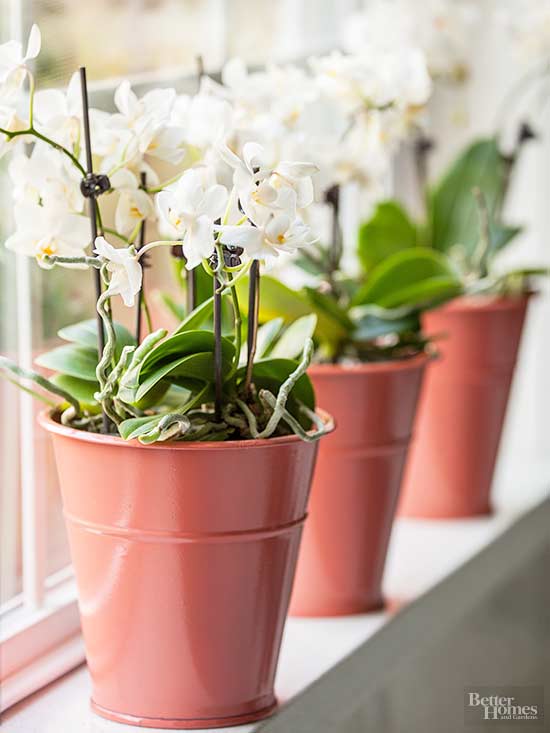






When watering orchids, the goal is to saturate the bark pieces, not the roots themselves. Always use room temperature water -- not cold, not hot. Avoid letting water stay inside the places where leaves meet the stems of an orchid; this promotes rot.
The best way to water orchids is to place the entire pot into a bowl that's at least as deep as the bark line. Pour room temperature water over the bark to just below the lip of the pot and let the bark soak for 10 to 15 minutes. If you put water in the bowl first, you're apt to push the bark out of the pot when you sink it into the water!
Then, lift the pot out of the water, let all of the excess water drain out, and place the orchid back in bright but indirect light.
Clay pots are great vessels for orchid plants because the terra-cotta also absorbs moisture, offering the orchid a little more humidity and water when the bark dries out.
continue reading belowSome orchids are grown in sphagnum moss. You can water these from the top, the way you water other plants. But be aware that sometimes moss can feel dry on top but it's still wet inside. Insert your finger up to the first knuckle inside the moss to determine if it's actually dry.
Sphagnum moss holds water pretty efficiently, so beware, especially if the orchid is also in a water-retaining plastic or glass pot. Orchid roots need air to grow. Too much water displaces all the air, thus rotting your orchid's roots.
Watering orchids is more of an art than a science. How often to water depends on a number of factors, including how warm it is, how much light the orchid gets, what type of orchid you have, and what type of potting medium the orchid is growing in.
A general rule of thumb is to water once a week for drought-tolerant types of orchids such as cattleyas, oncidiums, dendrobiums, and once every four or five days for others such as phalaenopsis.
All orchid mixes should be moistened thoroughly each time you water, then allowed to dry out before watering again.
Misting by hand does not need to be part of your orchid care. The idea is to raise the humidity, but you can do this more efficiently by placing orchid pots on top of a layer of rocks that are sitting in water. You don't want the water constantly touching the bottom of the pot; you just want the evaporation of the water to humidify the plant. You also can help your orchids by running a humidifier in the room where they live.
Ice cubes are not the best solution for watering orchids. Placing ice cubes on any part of an orchid can kill the plant. If you must use ice for convenience, be sure the cubes sit only atop the bark.
Many orchids bloom with no fertilizer. If you choose a liquid fertilizer, use it at half strength every other time you water. More fertilizer is not better. It's best to stop fertilizing when the plant is dormant, usually during the winter. Give plants a month or two without fertilizer. When temperatures rise and day length gets longer, begin fertilizing again.
Orchids perform well with a balanced formula of fertilizer (such as 10-10-10) or a fertilizer especially formulated to stimulate blooms, with a high middle number such as 11-35-15.
Always use a water-soluble fertilizer. Granular or stick types of fertilizers don't work well because, unlike how they perform in soil, they can wash out before getting a chance to interact with the bark mix.
Get more tips for growing orchids indoors.
See 10 of the easiest orchids to grow.
Copyright © www.100flowers.win Botanic Garden All Rights Reserved